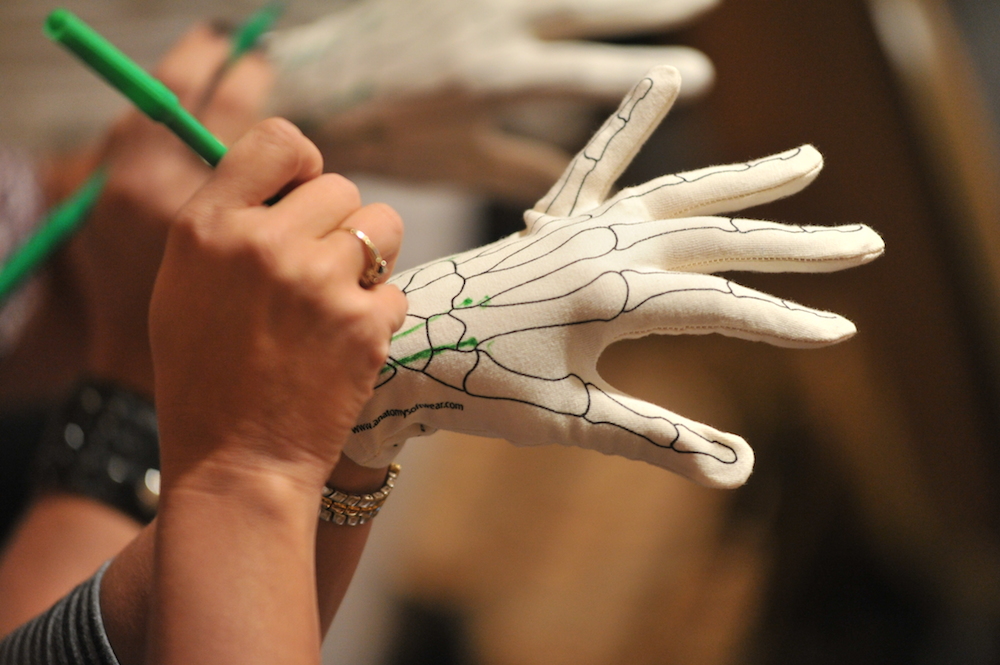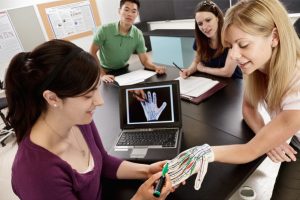Professors Pat McKee and Anne Agur are veteran educators in the University of Toronto’s Faculty of Medicine. While their passion is for teaching, creating a start-up company called Anatomy Softwear International Inc. turned them into entrepreneurs. Their invention, the Anatomy Glove Learning System, is now used in over 30 educational programs in over a dozen countries around the world.
Several years ago, Professors McKee and Agur began to think about how they could facilitate the teaching and learning of the complex anatomy of the hand. An early approach was to have students draw the anatomy onto paper, but they observed that two-dimensional diagrams did not adequately enable students to comprehend the anatomy of hand its functions. Since some of the muscles run from the front to the back of the hand, a 3-D method of learning became the goal. 
Professors McKee and Agur began to have their students draw the bones of the hand onto examination gloves, and then add the muscles. While comprehension seemed to be better, if the bones were not precisely drawn, then the muscles could not be accurately drawn onto the gloves. Agur and McKee realized that their students needed “a good canvas on which to draw the muscles.” Their solution was to create gloves with the bones printed on them. Their prototype was made using iron-on transfers from an inkjet printer to apply images of the hand bones onto the gloves. However, they soon found that doing so was too labour intensive and costly.
In 2008, Professors McKee and Agur sat down together to figure out how to improve on the anatomy glove learning system. With assistance from the Faculty of Medicine’s Education Deans Fund (EDF), they created instructional glove-drawing videos and began to research an economical, efficient method of creating gloves with bones printed on the front and back. Ideally, the gloves would be stretchy enough to accommodate different hand sizes. In addition, the bone images needed to be registered properly, meaning that when the user put the glove on, the images of the bones on the glove would align with those of the wearer, and the joints would be in the right place as well. According to McKee, “this requires a very precise printing process.” After a long search, they found one company to produce the stretchy, form-fitting gloves and a second company to print the bone images onto those gloves.
With the current Anatomy Glove Learning System, when students receive a “bony glove” they also get access to online instructional videos that show them exactly how to draw the muscles onto the glove, which helps students understand their functions. The learner-controlled videos allow the user to pause and draw at their own pace, and they can watch the video as many times as they want, which is something students cannot get in a conventional classroom.
 Since some hand structures are very complex and wrap around the hand, the three- dimensional glove is incredibly useful. According to McKee, “that three dimensional understanding is made so much easier, because you can see it on your own hand.” Even a rotational anatomy model on a computer is still two-dimensional and flat on the screen. Being able to draw the course of muscles around the hand is a unique feature of the Anatomy Glove Learning System.
Since some hand structures are very complex and wrap around the hand, the three- dimensional glove is incredibly useful. According to McKee, “that three dimensional understanding is made so much easier, because you can see it on your own hand.” Even a rotational anatomy model on a computer is still two-dimensional and flat on the screen. Being able to draw the course of muscles around the hand is a unique feature of the Anatomy Glove Learning System.
Professors McKee and Agur first used their new glove learning system with students at the University of Toronto in 2011. Since then, their project has expanded worldwide, and their invention is now being used at universities around the globe, including in South America, Europe, and Australia, in occupational therapy, physical therapy, massage therapy and anatomy programs. Even medical residents can benefit from the learning system.
Professor McKee has used the Anatomy Glove Learning System in conferences to teach occupational therapists, physical therapists, and hand therapists across Canada and the United States, as well as in Trinidad, Norway, Sweden, Brazil, and Italy. Students and educators have been providing feedback about their experiences with the Anatomy Glove Learning System, and the responses have been overwhelmingly positive.
Their story can be seen on their website, http://www.anatomysoftwear.com. When asked about their future goals, McKee and Agur spoke about lengthening the glove to include the forearm. Current expansion efforts are focused on translating their videos into different languages, including French, Spanish, and Mandarin, while they already have instructional videos in English and Portuguese. They are also developing more detailed videos for hand therapists and surgeons.

